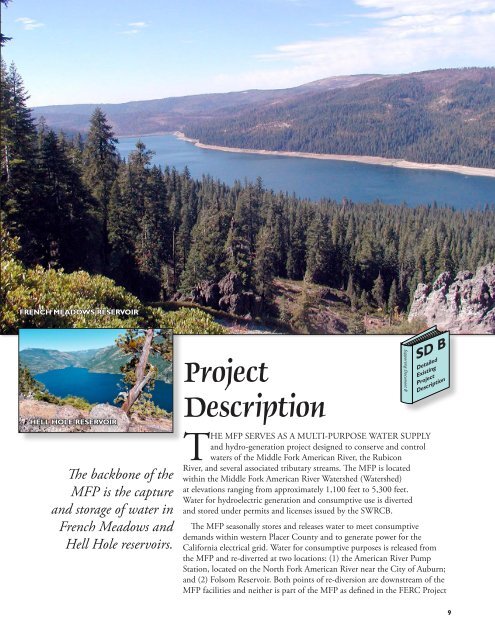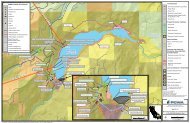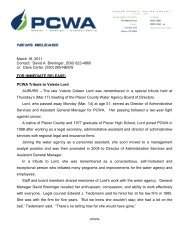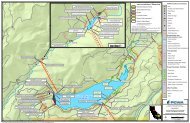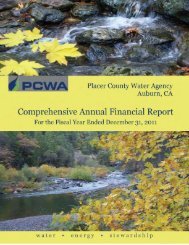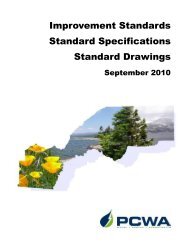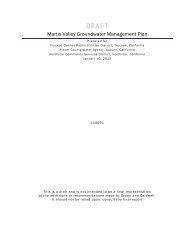Overview of Project Description - Middle Fork American River ...
Overview of Project Description - Middle Fork American River ...
Overview of Project Description - Middle Fork American River ...
- No tags were found...
You also want an ePaper? Increase the reach of your titles
YUMPU automatically turns print PDFs into web optimized ePapers that Google loves.
M i d d l e F o r k A m e r i c a n R i v e r P r o j e c tFrench Meadows reservoirHell Hole reservoirThe backbone <strong>of</strong> theMFP is the captureand storage <strong>of</strong> water inFrench Meadows andHell Hole reservoirs.<strong>Project</strong><strong>Description</strong>THE MFP SERVES AS A MULTI-PURPOSE WATER SUPPLYand hydro-generation project designed to conserve and controlwaters <strong>of</strong> the <strong>Middle</strong> <strong>Fork</strong> <strong>American</strong> <strong>River</strong>, the Rubicon<strong>River</strong>, and several associated tributary streams. The MFP is locatedwithin the <strong>Middle</strong> <strong>Fork</strong> <strong>American</strong> <strong>River</strong> Watershed (Watershed)at elevations ranging from approximately 1,100 feet to 5,300 feet.Water for hydroelectric generation and consumptive use is divertedand stored under permits and licenses issued by the SWRCB.The MFP seasonally stores and releases water to meet consumptivedemands within western Placer County and to generate power for theCalifornia electrical grid. Water for consumptive purposes is released fromthe MFP and re-diverted at two locations: (1) the <strong>American</strong> <strong>River</strong> PumpStation, located on the North <strong>Fork</strong> <strong>American</strong> <strong>River</strong> near the City <strong>of</strong> Auburn;and (2) Folsom Reservoir. Both points <strong>of</strong> re-diversion are downstream <strong>of</strong> theMFP facilities and neither is part <strong>of</strong> the MFP as defined in the FERC <strong>Project</strong>Supporting Document BSD BDetailedExisting<strong>Project</strong><strong>Description</strong>
M i d d l e F o r k A m e r i c a n R i v e r P r o j e c tPlacer County Farmer’s MarketThe MFP benefits the people <strong>of</strong> Placer County byproviding water and electricity.a well-lit Placer County communityLicense. PCWA’swater rights and watersupply agreementscurrently allow for theconsumptive use <strong>of</strong>up to 120,000 ac‐ft<strong>of</strong> MFP water perWater fountainat Local Parkyear. Consumptivewater supplied byPCWA is used tomeet municipal, industrial, and agricultural demands.Hydroelectric power from the MFP is produced atfive <strong>Project</strong> powerhouses with a combined nameplategenerating capacity <strong>of</strong> approximately 224 MW. Thetotal annual flow through the MFP and the resultingtotal annual generation are highly variable. The MFPproduces an average <strong>of</strong> 1,030,000 MWh annually onmean generation flows <strong>of</strong> 452,000 ac-ft. The highestannual generation was in 1983, a wet water year, whenthe MFP produced approximately 1,815,000 MWh onflows <strong>of</strong> 714,400 ac-ft. The lowest annual generationwas in 1977, a critically dry water year, when the MFPonly produced 211,000 MWh on flows <strong>of</strong> 75,000 ac-ft.<strong>Project</strong> FacilitiesThe MFP diverts, stores, and transports waterthrough a series <strong>of</strong> stream diversions, reservoirs, waterconveyance systems, and powerhouses before it isreleased back into the <strong>Middle</strong> <strong>Fork</strong> <strong>American</strong> <strong>River</strong>below Oxbow Powerhouse, approximately 29 milesupstream <strong>of</strong> Folsom Reservoir. Instream flow releasesbelow each diversion are made in accordance withFERC license requirements. All electricity generatedby the MFP is delivered to Pacific Gas and Electric’s(PG&E’s) transmission system at <strong>Project</strong> switchyardsand substations, typically located near powerhouses.PG&E’s transmission system is not part <strong>of</strong> the MFP.The backbone <strong>of</strong> the MFP is its two principal waterstorage reservoirs, French Meadows and Hell Hole. Thesereservoirs are located on the <strong>Middle</strong> <strong>Fork</strong> <strong>American</strong><strong>River</strong> and the Rubicon <strong>River</strong>, respectively, and have acombined gross storage capacity <strong>of</strong> 342,583 ac-ft.Starting at the highest elevation <strong>of</strong> the MFP, wateris diverted from Duncan Creek at the Duncan CreekDiversion and routed through the 1.5 mile-longDuncan Creek-<strong>Middle</strong> <strong>Fork</strong> Tunnel into FrenchMeadows Reservoir (134,993 ac-ft <strong>of</strong> gross storage).Flows in the <strong>Middle</strong> <strong>Fork</strong> <strong>American</strong> <strong>River</strong> arecaptured and stored in French Meadows Reservoir alongwith diversions from Duncan Creek. From FrenchMeadows Reservoir, water is transported via the 2.6mile-long French Meadows-Hell Hole Tunnel, passedthrough the French Meadows Powerhouse (installedgenerating capacity <strong>of</strong> 15.3 MW) and released intoHell Hole Reservoir (207,590 ac-ft <strong>of</strong> gross storage).Flows in the Rubicon <strong>River</strong> are captured and storedin Hell Hole Reservoir along with water releasedfrom French Meadows Reservoir through FrenchMeadows Powerhouse. Water released from Hell HoleReservoir into the Rubicon <strong>River</strong> to meet instreamflow requirements first pass through the Hell Hole10
Rubicon <strong>River</strong>M i d d l e F o r k A m e r i c a n R i v e r P r o j e c tPCWA PowerHeadquarters"><strong>Middle</strong> <strong>Fork</strong><strong>American</strong> <strong>River</strong>WatershedAreaEnlargedBelowFORESTHILLBlacksmith FlatRoadForesthill RoadNorth <strong>Fork</strong> <strong>of</strong> <strong>Middle</strong> <strong>Fork</strong> <strong>American</strong> <strong>River</strong>MIDDLE FORKAMERICAN RIVERWATERSHEDMosquito Ridge Road<strong>Middle</strong> <strong>Fork</strong>Interbay#*<strong>Middle</strong> <strong>Fork</strong>Powerhouse%Duncan CreekRobinsonFlatDuncan CreekDiversionFR 22<strong>Middle</strong> <strong>Fork</strong> <strong>American</strong> <strong>River</strong>%French MeadowsReservoirFrenchMeadowsDamNorth <strong>Fork</strong>/South <strong>Fork</strong>Long CanyonDiversionsDuncan Creek - <strong>Middle</strong> <strong>Fork</strong>TunnelFR 2South <strong>Fork</strong> Long CanyonNorth <strong>Fork</strong> Long Canyon%#*#*French Meadows - Hell HoleTunnelFrench MeadowsPowerhouseHell HoleReservoirHell Hole DamHell HolePowerhouseRalston - OxbowTunnelOxbowPowerhouse%#*RalstonAfterbay#*RalstonPowerhouseFR 23%Long Canyon<strong>Middle</strong> <strong>Fork</strong> - RalstonTunnelHell Hole - <strong>Middle</strong> <strong>Fork</strong>TunnelSouth <strong>Fork</strong> Rubicon <strong>River</strong>FR 2EllicottBridgePowerhouse (installed generating capacity <strong>of</strong> 0.73 MW),which is located at the base <strong>of</strong> Hell Hole Dam.From Hell Hole Reservoir, water is also transportedvia the 10.4 mile-long Hell Hole-<strong>Middle</strong> <strong>Fork</strong>Tunnel, passed through the <strong>Middle</strong> <strong>Fork</strong> Powerhouse(installed generating capacity <strong>of</strong> 122.4 MW) andreleased into the <strong>Middle</strong> <strong>Fork</strong> Interbay (175 ac-ft<strong>of</strong> gross storage). Between Hell Hole Reservoir and<strong>Middle</strong> <strong>Fork</strong> Powerhouse, water is diverted fromthe North and South <strong>Fork</strong>s <strong>of</strong> Long Canyon creeksdirectly into the Hell Hole-<strong>Middle</strong> <strong>Fork</strong> Tunnel.Water diverted from these creeks into the Hell Hole- <strong>Middle</strong> <strong>Fork</strong> Tunnel can either be stored in Hell HoleReservoir or be used to augment releases from HellHole Reservoir to the <strong>Middle</strong> <strong>Fork</strong> Powerhouse.Flows from the <strong>Middle</strong> <strong>Fork</strong> <strong>American</strong> <strong>River</strong>(including instream flow releases from French MeadowsReservoir) are captured at <strong>Middle</strong> <strong>Fork</strong> Interbay alongwith water released from Hell Hole Reservoir through<strong>Middle</strong> <strong>Fork</strong> Powerhouse. From <strong>Middle</strong> <strong>Fork</strong> Interbay,water is transported via the 6.7 mile-long <strong>Middle</strong> <strong>Fork</strong>-Ralston Tunnel, passed through the Ralston Powerhouse(installed generating capacity <strong>of</strong> 79.2 MW) and releasedinto the Ralston Afterbay (2,782 ac-ft <strong>of</strong> gross storage).Flows from the <strong>Middle</strong> <strong>Fork</strong> <strong>American</strong> <strong>River</strong> (includinginstream releases from <strong>Middle</strong> <strong>Fork</strong> Interbay) and flowsfrom the Rubicon <strong>River</strong> (including instream releases fromHell Hole Reservoir) are captured in Ralston Afterbayalong with water transported from <strong>Middle</strong> <strong>Fork</strong> Interbaythrough Ralston Powerhouse. From Ralston Afterbay,water is transported via the 400 foot-long Ralston-Oxbow Tunnel, passed through the Oxbow Powerhouse(installed generating capacity <strong>of</strong> 6.1 MW) and releasedfrom the MFP to the <strong>Middle</strong> <strong>Fork</strong> <strong>American</strong> <strong>River</strong>.In addition to these major water and power facilities,the MFP includes 35 <strong>Project</strong> roads (totaling almost 18miles) and 10 <strong>Project</strong> trails (totaling approximately 0.5miles). These roads and trails are used almost exclusively11
M i d d l e F o r k A m e r i c a n R i v e r P r o j e c tHell Hole boat ramp<strong>Project</strong> recreation facilities and reservoirssupport a variety <strong>of</strong> recreational activities.French MeadowscampgroundOxbow put-inby PCWA to access <strong>Project</strong>facilities. The <strong>Project</strong> roads andtrails represent less than 1% <strong>of</strong> thetotal miles <strong>of</strong> roads and trails inthe Watershed. There are also over6 miles <strong>of</strong> <strong>Project</strong> powerlines and communication lines,which provide power to operate <strong>Project</strong> equipmentand allow communication between <strong>Project</strong> facilities. Inaddition, numerous smaller facilities and features supportMFP operations including flow gaging stations andweirs, photovoltaic poles, microwave reflectors and radiotowers, sediment disposal sites, generator and storagebuildings, operator cottages, a maintenance shop, adormitory facility, and security and public safety fences.The MFP also includes 21 developed recreationfacilities to enable public access to public lands and<strong>Project</strong> reservoirs. The developed <strong>Project</strong> recreationfacilities are concentrated around French MeadowsReservoir, Hell Hole Reservoir, South <strong>Fork</strong> LongCanyon Diversion Pool, and Ralston Afterbay. PCWAis responsible for operation and maintenance <strong>of</strong> thesefacilities. The <strong>Project</strong> recreation facilities augmentother recreation facilities in the Watershed operatedby the TNF and ENF and the California Department<strong>of</strong> Parks and Recreation (DPR).<strong>Project</strong> OperationThe MFP has been operated for over 40 yearsby PCWA as a multi-purpose project to benefitthe people <strong>of</strong> Placer County. The MFP is operatedwith respect to four objectives, as follows:• Meet FERC license requirements that protectenvironmental resources and provide for recreation;• Meet the consumptive water demands<strong>of</strong> western Placer County;• Generate power to help meet California’s energydemand and provide valuable support servicesrequired to maintain the overall quality andreliability <strong>of</strong> the state’s electrical supply system; and• Maintain <strong>Project</strong> facilities to ensure theircontinued availability and reliability.<strong>Project</strong> operations for water supply and electric powergeneration are constrained by regulatory and contractrequirements, the physical capacities <strong>of</strong> the <strong>Project</strong>facilities, and water availability. Regulatory and contractrequirements include conditions imposed by the FERClicense, water rights permits, water delivery contracts,and the existing power purchase contracts with PG&E.Water availability is influenced by carryoverstorage in the <strong>Project</strong> reservoirs and thetiming and quantity <strong>of</strong> annual run<strong>of</strong>f.12
M i d d l e F o r k A m e r i c a n R i v e r P r o j e c tInflow (acre feet x 1,000)9008007006005004003002001000Annual operations are strongly influenced by inflow into the MFP.Typical annual operation <strong>of</strong> the <strong>Project</strong> results inthe capture <strong>of</strong> run<strong>of</strong>f which is diverted to increasestorage in French Meadows and Hell Hole reservoirsin the winter and spring (filling period), anddrawdown <strong>of</strong> the reservoirs during the summer, fall,and early winter (release period). Operation <strong>of</strong> theMFP varies from year-to-year based on the timingand magnitude <strong>of</strong> spring run<strong>of</strong>f, which is influencedby the amount <strong>of</strong> winter snow pack and ambienttemperature conditions, as well as precipitation.During the filling period, flows through the MFPpowerhouses are highly dependent on projected andactual run<strong>of</strong>f conditions. In drier years, power releasesare minimized during the filling period to increase thevolume <strong>of</strong> water in storage to meet upcoming summerconsumptive use and peak power demands. In wetteryears, power releases during the filling period areincreased to minimize spills from the reservoirs. In yearswhen minimum storage levels to meet consumptiveJan196719691971197319751977197919811983Energy Typical Demand Seasonal vs Demand Water Pattern DemandEnergy Demand (MW)Water Demand (Acre Feet)FebMarAprAnnual MFP InflowMayJun1985198719891991199319951997199920012003The MFP is operated to meet consumptive water and energydemands.JulAugSepOctNovDecdemands are reasonably assured and the chance <strong>of</strong> spillingis low, power releases are adjusted through the fillingseason based on the volume <strong>of</strong> water in storage, projectedrun<strong>of</strong>f, and current and projected power demands.During the release period, after the reservoirs havereached their maximum storage capacity, monthlyreleases for generation are largely predictable for theremainder <strong>of</strong> the year. However, daily and hourly releasesfor generation, which respond to demand for electricityand electrical grid reliability, remain highly variable.During the release period, flows are managed to: (1)meet storage and flow license requirements; (2) meetconsumptive water supply requirements; (3) optimizepower generation to meet peak electrical demand; and(4) achieve end-<strong>of</strong>-year carryover target storage levels.Decisions on the extent <strong>of</strong> the drawdown and theTypical Weekly Energy Demand and ProductionEnergy productionEnergy demandMon Tue Wed Thu Fri Sat SunThe ability <strong>of</strong> the hydroelectric project to generate electricityduring periods <strong>of</strong> peak demand maximizes the value <strong>of</strong> the MFP.carryover target storage level is based on balancing <strong>of</strong>competing needs including: (1) providing sufficientempty storage space to minimize potential spills fromthe reservoirs during the next filling period if therun<strong>of</strong>f is high (wet year); and (2) retaining enoughwater in storage to ensure that license requirementsand consumptive demands can be met in the followingyear if the next filling period run<strong>of</strong>f is low (dry year).Water supply operations take priority over powergeneration operations. However, in all but dry years,current water supply demands are easily met as aby-product <strong>of</strong> power generation. The reason is thatboth consumptive water and electrical demandstend to coincide seasonally and the MFP generallycontrols and releases far more water annually than13
M i d d l e F o r k A m e r i c a n R i v e r P r o j e c tThe <strong>Middle</strong> <strong>Fork</strong> and Ralston powerhousesaccount for over 90% <strong>of</strong> totalMFP power generation.Ralston powerhouse<strong>Middle</strong> <strong>Fork</strong> powerhouseThe heart <strong>of</strong> the MFPis generation producedat <strong>Middle</strong> <strong>Fork</strong> andRalston powerhouses.Critical elements <strong>of</strong> MFP operations✓ The flexibility to raise and lower water levels (water storage) atFrench Meadows and Hell Hole reservoirs at different rates andtimes throughout the year✓ The ability to release water from storage at the appropriate timeto meet an annual consumptive demand <strong>of</strong> up to 120,000 ac-ft✓ The ability to maximize generation during periods <strong>of</strong> highelectrical demand, especially in the summer and fall <strong>of</strong> dry yearswhen water availability may limit generating opportunities✓ The ability to simultaneously operate the <strong>Middle</strong> <strong>Fork</strong> and Ralstonpowerhouses (timing and flow) to maximize peak generationwhile avoiding spills at the <strong>Middle</strong> <strong>Fork</strong> Interbay✓ The ability to independently generate at Oxbow Powerhouse(decoupled from operations <strong>of</strong> the <strong>Middle</strong> <strong>Fork</strong> and Ralstonpowerhouses) by using the re-regulation capability <strong>of</strong> the RalstonAfterbay✓ The ability to shutdown the MFP annually for relatively shortperiods to perform routine maintenancePCWA requires to meet its consumptive water demand. The majority <strong>of</strong>PCWA’s consumptive deliveries are withdrawn from Folsom Reservoir,where the United States Bureau <strong>of</strong> Reclamation (USBR) allows for a 30-day balancing <strong>of</strong> supply and demand; thus hourly or even daily releasesfrom the MFP do not need to explicitly match consumptive deliveriesfrom Folsom Reservoir. Only the re-diversion <strong>of</strong> water for consumptivedemand at the <strong>American</strong> <strong>River</strong> Pump Station near Auburn (maximum100 cfs) requires hourly MFP system balancing to meet continuousminimum instream flows requirements below the pumping station.The <strong>Middle</strong> <strong>Fork</strong> and Ralston powerhouses are the heart <strong>of</strong> MFPgeneration. These two powerhouses generally run in tandem, using watertransported from Hell Hole Reservoir to RalstonAfterbay. Together the two powerhouses have a ratedcapacity <strong>of</strong> 201.6 MW and produce about 90%<strong>of</strong> the MFP annual generation. Although <strong>Middle</strong><strong>Fork</strong> Interbay is located between these powerhouses,<strong>Middle</strong> <strong>Fork</strong> Interbay has little ability to re-regulateflows because <strong>of</strong> its small storage capacity (175 acft).If the flows through the <strong>Middle</strong> <strong>Fork</strong> and Ralstonpowerhouses are not matched, <strong>Middle</strong> <strong>Fork</strong> Interbaywould be either drained or overtopped very quickly.These powerhouses, running in tandem, are <strong>of</strong>ten usedto help maintain reliable operations <strong>of</strong> the transmissiongrid by fine-tuning the flow <strong>of</strong> electricity in the grid tobalance supply and demand. When operated to providegrid regulation, flow rates through the powerhousesvary quickly to meet constantly changing energysupply and demand conditions. These powerhouses14
M i d d l e F o r k A m e r i c a n R i v e r P r o j e c tare also frequently block loaded. When block loaded,flows through the powerhouses are usually set atan efficient operating level and run for a prescribednumber <strong>of</strong> hours per day, depending upon hydrology.French Meadows Powerhouse is used when water ismoved from French Meadows Reservoir to Hell HoleReservoir. It is nearly always operated in block loadedcondition, with the duration <strong>of</strong> the block <strong>of</strong> operationset depending on the volume <strong>of</strong> water to be moved.Ralston Afterbay and Oxbow Powerhouse are thefinal steps in the MFP system. Oxbow Powerhousefrequently runs in tandem with <strong>Middle</strong> <strong>Fork</strong> and Ralstonpowerhouses. Presently, water is released from OxbowPowerhouse to the <strong>Middle</strong> <strong>Fork</strong> <strong>American</strong> <strong>River</strong> at thesame rate it enters Ralston Afterbay. However, RalstonAfterbay has sufficient operational storage capacity(about 1,200 ac-ft out <strong>of</strong> 2,782 ac-ft gross) to allowOxbow Powerhouse to operate independently <strong>of</strong> <strong>Middle</strong><strong>Fork</strong> and Ralston powerhouses for several hours at atime. This independent operational flexibility is usedto meet the ramping rate requirement downstream <strong>of</strong>Oxbow Powerhouse, and to make weekend releasesfor whitewater rafting without requiring operation<strong>of</strong> the <strong>Middle</strong> <strong>Fork</strong> and Ralston powerhouses.Testing and MaintenanceTo maintain and protect system reliability,PCWA conducts annual inspections, testing, andmaintenance <strong>of</strong> <strong>Project</strong> facilities. Annual maintenanceis scheduled at a time when the work can beexpeditiously completed (during favorable flow andweather conditions) and have the least effect onwater supply deliveries and power production.These activities typically occur for facilities in the lower<strong>Project</strong> area beginning in late September, and require thatthe lower MFP powerhouses (<strong>Middle</strong> <strong>Fork</strong>, Ralston, andOxbow) be taken out-<strong>of</strong>-service for 3-6 weeks. Duringthe fall maintenance period, <strong>Middle</strong> <strong>Fork</strong> Interbay andRalston Afterbay water levels are lowered to allow accessto the facilities. Consumptive demands and instreamflow requirements downstream <strong>of</strong> Oxbow Powerhouseduring the fall outage are typically met by increasing flowreleases from Hell Hole Reservoir into the Rubicon <strong>River</strong>.Inspection, testing, and the maintenance <strong>of</strong> facilities inthe upper <strong>Project</strong> area (i.e., French Meadows and HellHole powerhouses), typically occur during the spring,once the roads to the <strong>Project</strong> facilities are passable.Sediment removal atNorth <strong>Fork</strong> Long Canyon Diversion PoolOngoing maintenance isessential for system reliability.PCWA also implementsroutine maintenanceactivities within andaround <strong>Project</strong> facilities to:• Preserve <strong>Project</strong>flow and storagecapacities byimplementingsediment anddebris management;Maintenance atInterbay Dam• Protect worker and public health andsafety by implementing vegetationmanagement, pest management, signage,and erosion and rock control measures;• Provide facility access by implementingroad and trail maintenance; and• Protect facility reliability by implementingequipment maintenance, erosion and rockcontrol measures, facility painting, and powerlineand communication line pole replacement.For <strong>Project</strong> recreational facilities, PCWA has ongoingagreements with the TNF and ENF under whichit provides the financial resources necessary to supporta portion <strong>of</strong> the operation and restoration <strong>of</strong> thesefacilities by the respective National Forests. PCWA alsohas a cost-sharing agreement with the TNF and ENF tocontribute funding for a portion <strong>of</strong> road maintenanceon non-<strong>Project</strong> Forest Service roads used by PCWA.15


